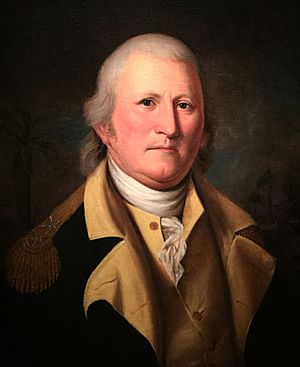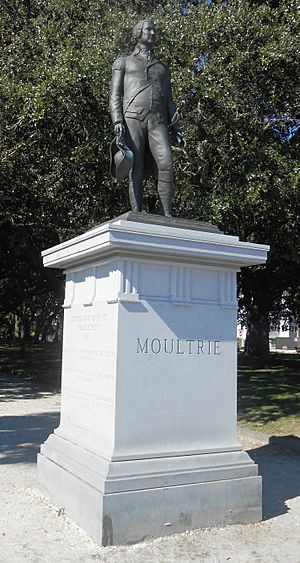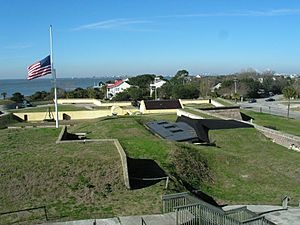William Moultrie facts for kids
Quick facts for kids
William Moultrie
|
|
|---|---|

Portrait of William Moultrie by Charles Willson Peale, 1782
|
|
| 35th Governor of South Carolina | |
| In office December 5, 1792 – December 17, 1794 |
|
| Lieutenant | James Ladson |
| Preceded by | Charles Pinckney |
| Succeeded by | Arnoldus Vanderhorst |
| In office February 11, 1785 – February 20, 1787 |
|
| Lieutenant | Charles Drayton |
| Preceded by | Benjamin Guerard |
| Succeeded by | Thomas Pinckney |
| 10th Lieutenant Governor of South Carolina | |
| In office February 16, 1784 – February 11, 1785 |
|
| Governor | Benjamin Guerard |
| Preceded by | Richard Beresford |
| Succeeded by | Charles Drayton |
| Personal details | |
| Born | November 23, 1730 Charlestown, Province of South Carolina, British America |
| Died | September 27, 1805 (aged 74) Charleston, South Carolina, U.S. |
| Military service | |
| Allegiance | |
| Branch/service | |
| Years of service | 1761 1775 – 1783 |
| Rank | Major General |
| Unit | 2nd South Carolina Regiment |
| Battles/wars | Anglo-Cherokee War American Revolutionary War *Battle of Sullivan's Island *Battle of Beaufort *Siege of Savannah *Siege of Charleston |
William Moultrie (born November 23, 1730 – died September 27, 1805) was an important leader from South Carolina. He was a farmer and politician who became a general during the American Revolutionary War. In 1776, as a colonel leading a local army, he stopped the British from taking Charleston. A fort, Fort Moultrie, was later named in his honor.
After the war, Moultrie became a successful politician. He was elected by the state's lawmakers to be the Governor of South Carolina twice. He served from 1785 to 1787 and again from 1792 to 1794. The state's rules at the time did not allow governors to serve two terms in a row.
Contents
William Moultrie's Early Life and Military Career

William Moultrie was born in Charles Town, which was then part of the British Province of South Carolina. His parents were Dr. John Moultrie, a Scottish doctor, and Lucretia Cooper. William grew up learning how to manage a farm.
Moultrie first fought in the Anglo-Cherokee War in 1761. This was before the start of the American Revolution. Later, he was chosen to be part of the local government assembly for St. Helena Parish.
Fighting for Independence
In 1775, Moultrie became a colonel in the 2nd South Carolina Regiment, a group of local soldiers. A year later, in 1776, he bravely defended a small fort on Sullivan's Island. This fort was later named Fort Moultrie to honor him. His defense stopped British commanders Sir Henry Clinton and Sir Peter Parker from capturing Charleston.
The Continental Congress, which was the government for the American colonies, thanked Moultrie for his actions. He was promoted to brigadier general. His regiment then joined the main American army, called the Continental Army.
Key Battles and Capture
In February 1779, Moultrie successfully pushed back the British at Port Royal. Later that spring, when Major General Benjamin Lincoln took most of the American army towards Augusta, Georgia, Moultrie stayed behind. He had a small group of soldiers at Black Swamp to watch the British across the Savannah River.
When the British suddenly crossed the river and tried to attack Charleston, Moultrie showed great skill. He led a careful retreat across the Coosawhatchie and Tullifiny Rivers, all the way back to Charleston. There, he held off a short attack. He refused to give up, even when some local leaders in Charleston felt abandoned and were ready to surrender.
In 1780, Moultrie was captured when Charleston finally surrendered to the British. While a prisoner, he was put in charge of the American prisoners of war. He had to be very patient and skilled to speak up for his men against the strict British commander. The British even tried to get him to join their side, but Moultrie strongly refused. He was later traded for British prisoners. In 1782, during the last year of the war, he was promoted to major general. He was the last person to be given this rank by Congress during the war.
Governor of South Carolina
After the war, the new state government elected William Moultrie as the 35th Governor of South Carolina. He served from 1785 to 1787. The state's rules at the time did not allow a governor to serve two terms in a row. This rule was meant to keep power with the lawmakers. However, Moultrie was elected again by the legislature in 1792 and served until 1794.
Moultrie was also the first president of the South Carolina branch of the Society of the Cincinnati. This was a group for officers who fought in the Revolutionary War. He led the group until his death. In 1802, he wrote a book about his experiences called Memoirs of the Revolution as far as it Related to the States of North and South Carolina.
William Moultrie's Legacy
After the Revolutionary War, the fort that William Moultrie had defended was renamed Fort Moultrie in his honor. This fort was a very important defense point until Fort Sumter was built. Fort Moultrie was used by the United States Army from 1798 until the end of World War Two.
Other places were also named after him. Moultrie County, Illinois is one example. Also, a town in Georgia called Ochlockoney was renamed Moultrie in 1859.
The Moultrie Flag
During his famous defense of the fort in 1776, a special flag designed by Moultrie himself was flown. This flag was blue with a white crescent moon and the word "LIBERTY" on it. During the battle, the flag was shot down. A brave soldier named Sergeant William Jasper picked it up and held it high to encourage the troops. This story became very well known.
The flag became a symbol of the Revolution in the Southern states. It was called the Moultrie Flag or the Liberty Flag. The new state of South Carolina later used its design as part of its official state flag.




